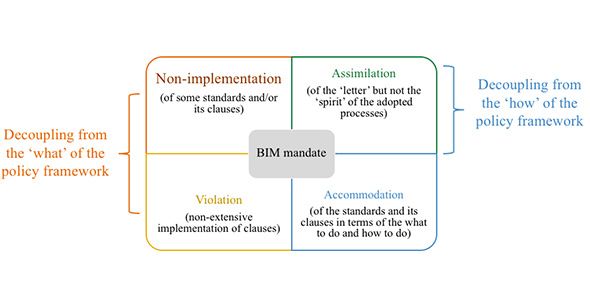
Submitted by Angela Walters on Mon, 19/10/2020 - 15:03
New research by Thayla Zomer, a PhD researcher at the Centre for Digital Built Britain (CDBB), University of Cambridge, Professor Andy Neely, Director of CDBB and Dr Ajith Parlikad, explores how organisational aspects and existing ways of working can affect the implementation of built environment policy and limit the extent to which organisations and projects fully realise its benefits.
The paper was awarded the ARCOM best paper award for Transformation of the Construction Industry at the ARCOM 2020 conference in September.
Thayla explains more about the research and how CDBB, the Construction Innovation Hub and the UK BIM Framework provides guidance and support to advance the adoption and proper implementation of BIM in the UK.
The implementation of the UK BIM Framework has the potential to improve productivity and transform construction practice. It became mandatory for many Government commission building projects in 2016. This research draws on institutional theory to explore why early BIM adoption diverged or ‘decoupled’ from policy makers’ intent and why transformation of the industry has been slower than expected.
The study analysed real world implementation of the mandate across a representative set of projects from both public-sector and private-sector client organisations and revealed four different ways that projects might respond to institutional pressures from the environment.
In-depth and longitudinal analysis of practical enactment of the BIM mandate across all lifecycle stages of the analysed projects over a two year period revealed that, although BIM adoption has increased over the years since it became compulsory in the UK, there is still considerable diversity in practical enactment.
Non-implementation
The first way that projects responded to the mandate was through non-implementation of the adopted standards, processes and procedures as part of the framework. Non-implementation usually occurs in two main forms:
- Lack of adoption or implementation of one or more principle, standard or document as part of the framework
- Although the principle, standard or document is adopted, some of its clauses or prescriptions and respective processes have not been followed. In other words, projects decouple the formal policy and prescriptions that follow it from actual practice.
Violation
On other occasions, although standards have been adopted, extensive implementation has not happened. In other words, the clause, process or activity has been ‘violated’ or its implementation has not fully complied with the ‘letter’ of the standard or document which forms part of the framework.
Assimilation
A superficial implementation of some processes and activities was also observed as a common characteristic of practical implementation. Commonly among the projects, some processes and activities have been implemented, but the envisaged goals have not always been achieved. Although the 'letter' of the BIM policy and standards had been followed if project stakeholders do not understand the ‘spirit’ and make the necessary institutional change, implementation will not occur as envisaged increasing the likelihood of not realising the expected benefits.
Accommodation
Finally, accommodation is when the processes and activities as suggested by the standards have been fully implemented in the way they should be and project stakeholders have transformed pre-existing structures to accommodate the new processes and activities. In other words, project stakeholders engaged with the pressures from the environment in a way that led them to restructure existing structures to accommodate the new practices.
The findings reveal that broad diffusion may well generate wider variety at the ground level, and that the pace of the transformation across the sector is influenced by such differences in the responses employed by projects, revealing a decoupling phenomenon.
The underlying causes of such responses include institutionalised ways of working, procedures, norms, roles and governance systems, at both industry and organisational levels, that have not been reconfigured with the adoption of new practices.
To address this and support the consistent implementation of BIM in the UK, BSI, CDBB, and the UK BIM Alliance established the UK BIM Framework to provide guidance for managing information provided by the new ISO 19650 series. The new standards are more guiding, prescriptive and detailed than before and have been developed in partnership with industry and the public sector and informed by how they will be applied in practice.
CDBB develops and shares knowledge to inspire an industrial community who work together with academics and policy makers to provide leadership on adopting and implementing new digital approaches including the UK BIM standards.
See: Zomer,A; Neely.A and Parlikad, A (2020) Institutional pressures and decoupling in construction projects: an analysis of Building Information Modelling (BIM) implementation. https://www.repository.cam.ac.uk/handle/1810/310953

